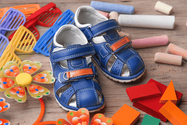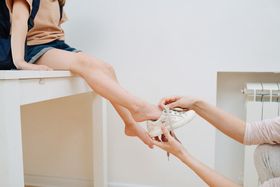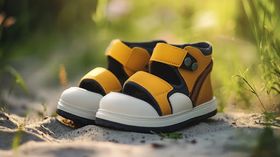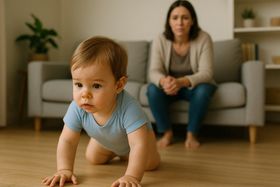Bowlegged to Straight: Understanding Your Baby's Leg Development
Discover the fascinating journey of your baby's leg development and learn how to support their healthy growth.
Updated January 7, 2025
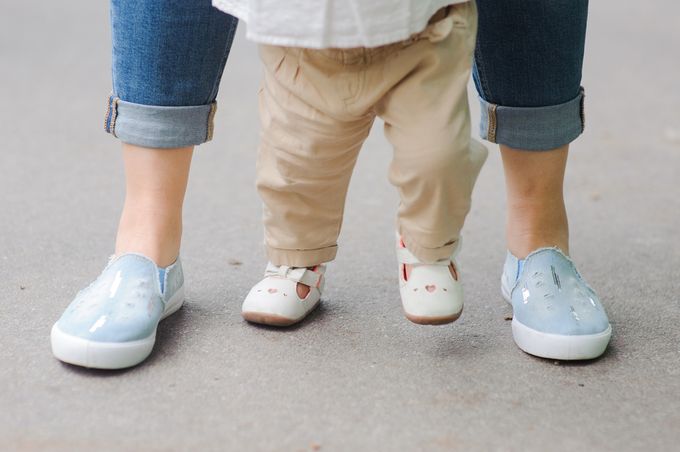
Is your child's walk a bit wider than you expected? Do their knees seem to point out when they stand? While often harmless, bowlegs in children can raise questions about their development and future mobility.
This blog will guide you through the typical stages of a baby's leg development, offering reassurance and practical tips to support their healthy growth.
» Give your kid confidence with shoes designed to support bowlegs
What Are Bowlegs?
Bowlegs, medically known as genu varum, is a condition where a child's legs curve outward at the knees. When your child stands with their feet together, you'll notice their knees don't touch, creating a distinctive bow-like appearance.
This condition is incredibly common during early childhood and typically represents a normal developmental phase rather than a cause for concern.
» Can bowlegs be corrected? Find out what experts say
Why do newborns have bowed legs?
During pregnancy, babies develop in a confined space that requires their legs to remain flexed. While perfect for womb life, this positioning results in the characteristic bow-legged appearance after birth.
As your child grows and bears weight on their legs, this natural curvature usually begins to straighten independently.
Did you know?
Many kids experience a phase between ages 3 and 5 when their legs temporarily shift into a knock-kneed position. This demonstrates the dynamic nature of childhood development and shouldn't cause alarm.
» Read our parents' guide to helping your little one to walk
Stages of Leg Development
Understanding your child's leg development timeline can help you better appreciate and support their growth. Let's explore each crucial stage:
Early Beginnings (0–2 Months)
During these first precious weeks, your baby's leg movements are primarily driven by natural reflexes. When you hold them on your lap, you'll notice they instinctively push against surfaces with their feet.
Around six weeks, these reflexive movements gradually become more purposeful as your baby's coordination develops.
» Which is better? Regular shoes vs. supportive shoes for kids
Building Strength (3–6 Months)
This period marks an exciting phase in your baby's development as they begin actively strengthening their legs. You might notice them bearing weight through their legs and showing enthusiasm for bouncing when supported in a standing position. These early "pre-walking" movements are crucial building blocks for future mobility.
Preparing for Mobility (6–10 Months)
The 6–10 month period brings remarkable muscle control and coordination progress. Many babies begin crawling during this time, masterfully combining leg and trunk movements. You'll likely witness your little one pulling themselves up on furniture, eager to explore their vertical world.
Tip: Create a safe environment by removing sharp objects and placing cushions around standing areas. It's perfectly normal for your baby to stand on their tiptoes during this phase initially.
» Check out our list of best shoes for tippy-toe walkers
First Steps (10–12 Months)
Around their first birthday, many babies achieve the milestone of independent standing and may venture to take their first unassisted steps. Some babies might start a bit earlier or later, but you might see your little one bravely letting go of the furniture and taking those wobbly first steps around this time.
» Support their first steps with shoes for learning to walk
How to Support Your Baby’s Leg Development
Letting your kid move freely is essential for muscle development. As babies naturally stretch and exercise their leg muscles, they develop healthier walking patterns. This natural strengthening process gradually enables them to achieve standing milestones.
Here are some practical ways to support your baby’s leg development and the correction of bowlegs:
- Playtime: Engaging your infant in various movements during playtime helps strengthen leg muscles. Activities like kicking, crawling, rolling, and reaching for toys promote muscle development and enhance the strength and coordination of their legs.
- Gentle exercises: Age-appropriate physical exercise is essential for promoting overall motor development in babies. If your baby has stiffness in their legs, you can gently massage and cycle their legs.
- Frequent tummy times: Regular tummy time sessions are crucial as they strengthen the neck, back, and shoulders and develop core muscles. Strong core muscles contribute to better posture and balance and positively influence leg development.
- Supportive Shoes: Supportive pre-walker shoes for infants often have features such as arch support, cushioning, and ankle stability. These features can help promote proper foot, ankle, and leg alignment, which is important for healthy leg development.
Supporting Your Baby's First Steps
Remember, your baby's bowlegs are a natural stepping stone in their development journey. While most children outgrow this by age 2, don't hesitate to check with your doctor if the bowing is worsening or if your little one seems uncomfortable.
The right shoes can make supporting your baby's first steps easier. First Walkers creates shoes that give your tiny explorer the confidence to discover their world. They provide the right balance of protection and support while your little one discovers the world.
And don't forget—those precious feet also need their freedom! Make sure to include plenty of barefoot time at home for natural foot development.
» Concerned about bow legs? Invest in shoes that prioritise healthy foot development
Disclaimer: First Walkers' information is intended for educational and informational purposes related to toddler footwear and feet. We encourage you to consider individual circumstances and consult qualified orthopaedists about specific conditions.
